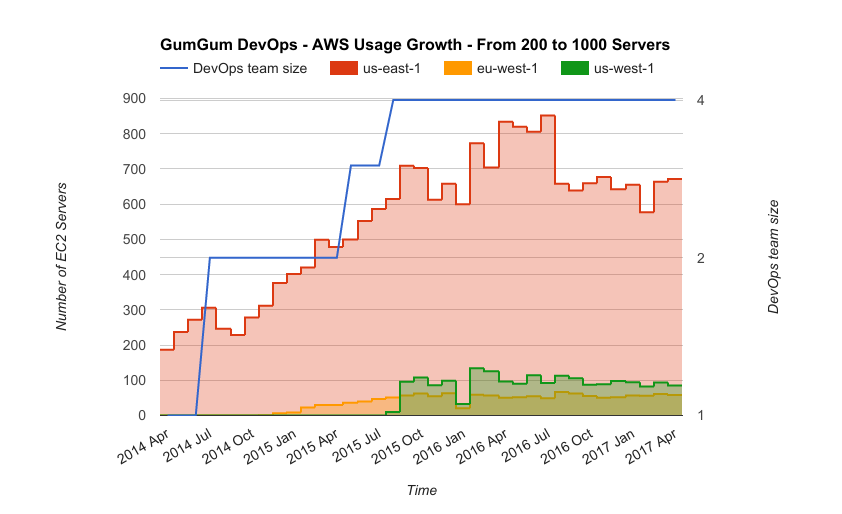Gumref
Code Pipelines with Docker
- Ansible Container - Jenkinsfiles - AWS ECS -

Florian Dambrine - Senior DevOps Engineer
@DambrineF

> Agenda
-
Why do we need GumRef ?
-
What is GumRef ?
- Ansible-container
- Jenkins Pipelines
-
AWS Elastic container service (ECS)
- Gumref Demo
> Why do we need gumref ?
2017 Team ratios
~ 7 Engineers
~ 20 Engineers
~ 3 Engineers
~ 12 Engineers

10.5 Engineers for 1 DevOps
~ 4 Engineers
> Why do we need gumref ?

250 servers for 1 DevOps
2017 GumGum Infrastructure
> Why do we need gumref ?
- Even with a DevOps team, developers are usually waiting for Ops to spin up environments or infrastructure components. Let's automate the last mile !
- Environment parity and standardization
- Parity:
- feature branch > dev > stage > prod
- Standardization:
- An application should follow a certain skeleton
- An application should follow a certain skeleton
- Parity:
- Development efficiency (Image science builds -> ~1h )
- Better integration between applications
- Faster and safer deployments
> What is gumref ?
- It is a Framework made of:
- Ansible Container -> Docker
- Jenkins pipeline -> CI / CD
-
AWS ECS -> Infrastructure running containers
- An application project implementing the Gumref framework must:
- Contain the git submodule gumref (might change)
- Copy the Gumref Jenkinsfile (CI / CD pipelines)
- Copy and edit the Gumref Jenkinsfile.properties (pipeline strategy)
- Create and implement an ansible-container project for the application
> gumref - Dockerfile VS ansible-container
#!/bin/bash
Configuration Management
Dockerfiles
Ansible Container


Before 2000
2008 - 2014
2014 - 20XX
2016 - 20XX
> GUMREF - DOCKERFILE VS ANSIBLE-CONTAINER
### Dockerfile
FROM nvidia/cuda:7.5-cudnn5-devel-ubuntu14.04
RUN apt-get update \
&& apt-get -y install \
software-properties-common python-software-properties \
&& add-apt-repository -y 'ppa:ubuntu-toolchain-r/test' \
&& apt-get -y update \
&& apt-get -y install \
gcc-4.9 \
g++-4.9 \
build-essential \
cmake \
git \
wget \
python-dev \
python-pip \
python-boto python-botocore \
libssl-dev \
libcurl4-openssl-dev \
libjsoncpp-dev \
libprotobuf-dev \
libleveldb-dev \
protobuf-compiler \
libgflags-dev \
libgoogle-glog-dev \
libsnappy-dev \
liblmdb-dev \
libhdf5-serial-dev \
python$PYTHON_VERSION-dev \
unzip \
libatlas-base-dev \
gfortran \
libjasper-dev \
libgtk2.0-dev \
libavcodec-dev \
libavformat-dev \
libswscale-dev \
libjpeg-dev### container.yml
---
version: "2"
services:
image-science-base:
image: "nvidia/cuda:7.5-cudnn5-devel-ubuntu14.04"
roles:
- image-science-base### roles/image-science-base/tasks/main.yml
---
- name: Install apt dependencies
apt:
state: present
name: "{{ item }}"
update_cache: yes
with_items:
- software-properties-common
- python-software-properties
- name: Add toolchain PPA
apt_repository:
state: present
repo: 'ppa:ubuntu-toolchain-r/test'
- name: Install apt packages
apt:
state: present
name: "{{ item }}"
update_cache: yes
with_items:
- gcc-4.9
- g++-4.9
- build-essential
- cmake
- git
- wget
- python-dev
- python-pip
- python-boto python-botocore
- libssl-dev
- libcurl4-openssl-dev
- libjsoncpp-dev
- libprotobuf-dev
- libleveldb-dev
- protobuf-compiler
- libgflags-dev
- libgoogle-glog-dev
- libsnappy-dev
- liblmdb-dev
- libhdf5-serial-dev
- python$PYTHON_VERSION-dev
- unzip
- libatlas-base-dev
- gfortran
- libjasper-dev
- libgtk2.0-dev
- libavcodec-dev
- libavformat-dev
- libswscale-dev
- libjpeg-dev- Leverage DevOps ~200 Ansible roles
- Keep things readable understandable and maintainable
- Offer more than Docker:
- Container orchestration
- Dev to Prod Framework
> Gumref - Jenkins pipelines

#!groovy
pipeline {
agent any
stages {
stage('PREPARE') {...}
stage('BUILD') {...}
stage('UNIT_TESTS') {...}
stage('INTEGRATION_TESTS - Start up containers') {...}
stage('INTEGRATION_TESTS - Run integration tests') {...}
stage('INTEGRATION_TESTS - Shutdown containers') {...}
stage('CREATE_RELEASE') {...}
stage('DEPLOY_DEV') {...}
stage('QA_DEV') {...}
stage('DEPLOY_STAGING') {...}
stage('QA_STAGING') {...}
stage('OPS_SIGNING') {...}
stage('DEPLOY_PROD') {...}
}
}
- Pipeline definition is part of the application Git repository
- They define the way the application should be continuously integrated and deployed
- They can track and integrate multiple Git branches
Ops Team still working on Branching strategy and will figure out exactly what to do in the coming week with them
> Gumref - AWS ecs infrastructure
Web Team
Image Science Team
Data Science Team

















ds.ecs.va.ggops.com
image.ecs.va.ggops.com
web.ecs.va.ggops.com
Application Load Balancers (ALB)
ECS Clusters
/<application>/<env>
/tws/DS-123

/logoserver/dev
/vertex/stage
/adbuilder/GS-987
/adbuilder/stage
Route 53 DNS
target B
target A
target C
target D
target F
target E
> Gumref - Demo
- Create a branch from the Jira ticket
- Check what happened on Jenkins Team server
- Check what happened on AWS
- Prove I am not cheeting :)
- Show important things from container.yml and roles
- Build the ansible-container project locally
-
Run the ansible-container project in dev mode
- Explain how to install new dependencies
-
Run the ansible-container project in prod mode
- Explain the results
- Commit and push
- Merge back to dev stage and master